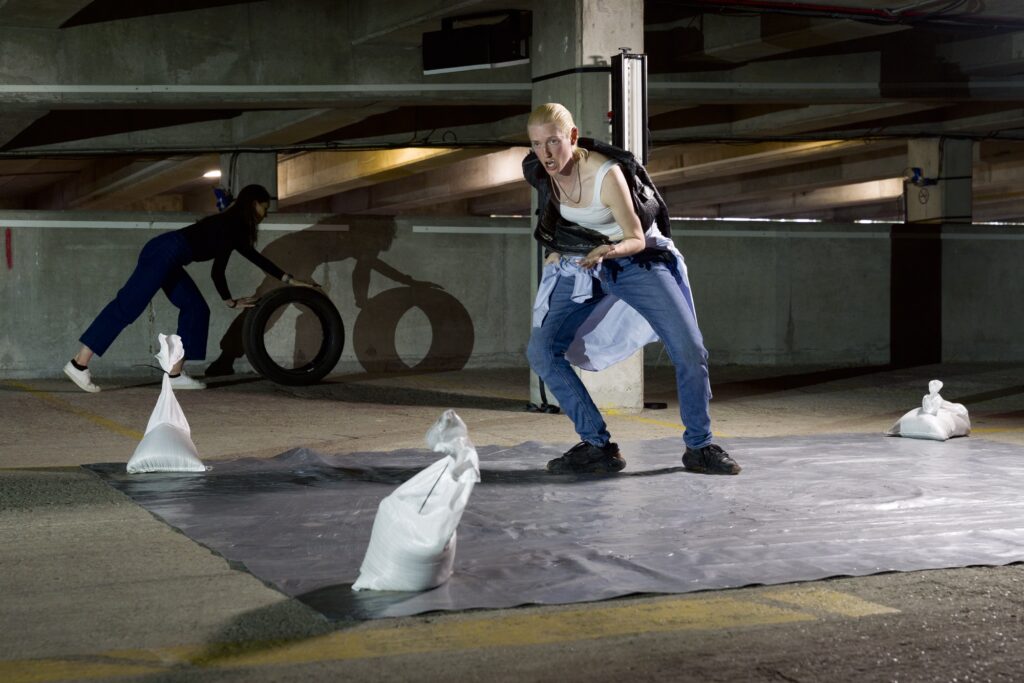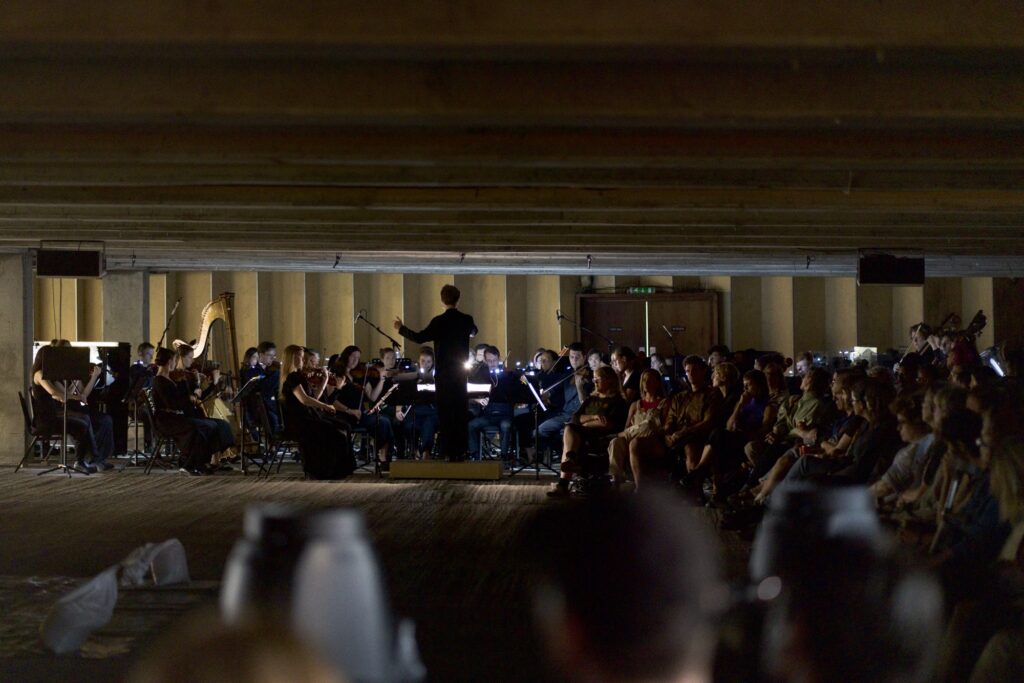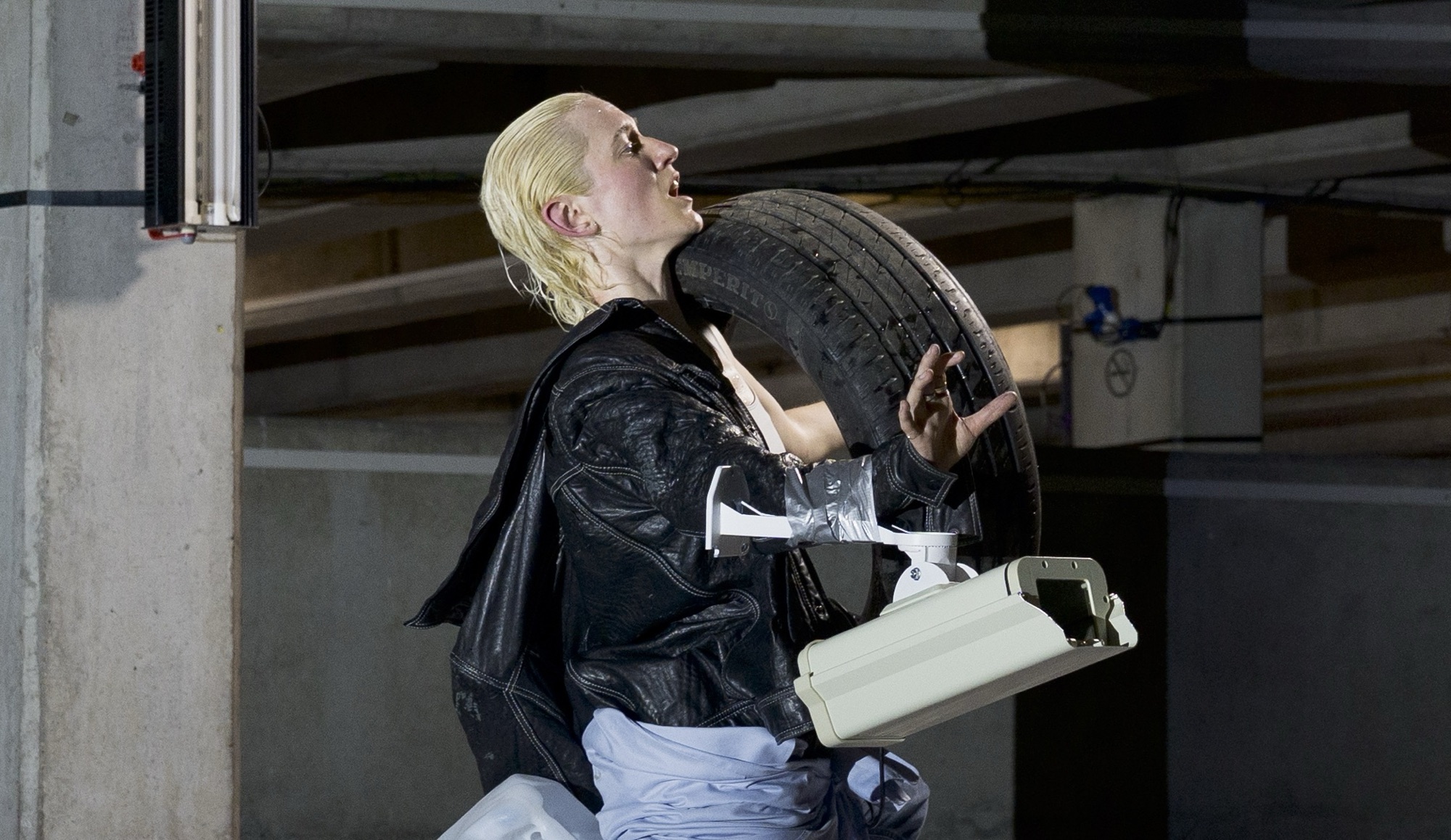Words by Florence Nicholls.
I went into this performance not having come across Eve Stainton’s work before. But, a solo choreography built on riot arrest imagery and 1980s Crime Watch TV, accompanied by a live orchestra rendition of Ennio Morricone’s seminal film score ‘The Thing’ sounded audacious and frankly unmissable.
In The Joystick and The Reins, Eve Stainton moves in complete slow motion, sifting through an imagery of people under threat and ready to attack, in defense and surrendering in fear.
The performance was hosted and co-commissioned by Bold Tendencies, atop the Peckham Levels building. On the rooftop, we were given stickers and sent on the hunt for the venue. We went left at the bush, down the ramp into a carpark-turned-industrial performance space. The location was silhouetted in evening light that cast a haze over the skyline. It was the perfect setting for The Joystick and The Reins: immersive, cinematic and tense.
As it was time to begin, Stainton circled the venue, drawing the curtains closed which left us in almost complete darkness for the long and suspenseful moments of the opening score played out by the Sinfonia Smith Square Orchestra. For the first time in history, Ennio Morricone’s composition was performed in full. The score was prepared by the Morricone Estate, specially for the project. ‘The Thing’ soundtrack, accompanying swathes of stillness, empty space and minimal objects heightened the tension in Stainton’s barely-moving gestures, clenched jaw and fists.
Every millimetre of motion held visual significance. Stainton was slowing down their process of transformation, morphing image to image with minuscule adjustments. The effect was one of palpable tension amongst the audience. Not knowing when this intensity would come to a head, I anticipated some kind of physical eruption. A break-away moment that would send Stainton catapulting into a series of explosive moves that never came. Instead, for the duration of the performance, Stainton continued to adjust frame by frame. Then, selected members of the audience instigated the gear shifts, attaching clothes, tyres and CCTV cameras to Stainton, slowly but surely increasing their physical toll.

But the pressure was not only mounting for Stainton as they resisted this physical weight. The Joystick and The Reins interrogates power and how it is utilised as an oppressive force by hegemonic structures, making vulnerable those who do not conform. Stainton’s practice is intertwined with community. Looking back over their previous works from Dykegeist to Impact Driver and now The Joystick and The Reins, it is apparent that Stainton’s artistic life is deeply rooted in social politics and identity. Beyond the stage and embedded within their movement research, Stainton seems to be picking apart the rules of convention in art, to hold a mirror up to society.
In line with Stainton’s out-of-the-ordinary approach to dance making, this work saw moments of audience engagement paired with moving sculpture and conceptual set design to bring to life an eerie, underground world. Stainton is handed a brick. Worn out and fighting to stay up, they come head to head with the conductor (Jack Sheen) dressed up in a police jacket. In this moment we see a literal expression of Stainton’s ideas about power structures, oppression and resistance. The conductor, however, is barely conscious, led across the stage to Stainton by his back, eyes closed as if in a dream. Stainton lets the brick fall from their grasp. The conductor strips himself of his uniform, turns his back and rejoins the orchestra. In some way, they admit to a mutual surrender. Disarming themselves of their respective weapons.

This piece of work has stayed with me since. Visually, it’s burned on my brain. In all of its stillness and tension there was time, and so much of it, to look between the lines and become absorbed in the details. I spent the hour making up my own stories that blended and blurred into each other. Petrol poured over Stainton’s head in one act of violence appeared like sweat in the next. Dripping from their forehead as they emerged from a terrible fight…
Finally, Stainton surrendered their weight to the floor. As their body was swept out of sight on a tarpaulin, I imagined the final credits rolling. The Sinfonia Smith Square Orchestra played the closing music of Morricone’s score and the audience broke out in unstoppable applause as Stainton ran to take their bow with Sheen and the 52 musicians, celebrating a courageous and exceptional debut.
